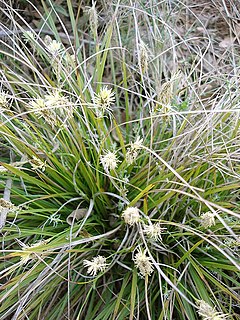
Carex is a vast genus of more than 2,000 species of grass-like plants in the family Cyperaceae, commonly known as sedges. Other members of the family Cyperaceae are also called sedges, however those of genus Carex may be called true sedges, and it is the most species-rich genus in the family. The study of Carex is known as caricology.

Carex vesicaria is an essentially Holarctic species of sedge known as bladder sedge, inflated sedge, and blister sedge. It has been used to insulate footwear in Norway and among the Sami people, and for basketry in North America.

Carex specuicola is a rare species of sedge known by the common name Navajo sedge. It is native to a small section of the Colorado Plateau in the United States, its distribution straddling the border between Utah and Arizona, and completely within the Navajo Nation. There are several populations but they are limited to a specific type of habitat. The plants grow from the sides of steep, often vertical cliffs of red Navajo Sandstone, in areas where water trickles from the rock. It occurs at elevations between 5,700 and 6,000 feet, usually in shady spots. Though it is not a grass, the sedge grows in inconspicuous clumps resembling tufts of grass sticking out of the rock face. When the sedge was federally listed as a threatened species in 1985, it was known from only three populations in Coconino County, Arizona, with no more than 700 plants existing. The species has since been observed in northeastern Arizona and San Juan County, Utah.
Carex autumnalis is a species of flowering plant in the sedge family, Cyperaceae. It was first formally named by Jisaburo Ohwi in 1930. Carex autumnalis is native to Japan and mainland eastern Asia, from southeastern China to North Korea. In China it grows in shady ravines.
Carex vicinalis is a species of sedge that was first described by Francis Boott in 1867. It is native to southern India. The type specimen was collected at the Nilghiri Hills.

Carex siccata, common names including dryspike sedge, is a species of Carex native to North America. It is listed as endangered in New Jersey. As of May 2021, USDA Plants regards Carex foenea as a synonym of C. siccata, whereas the World Checklist of Selected Plant Families regards only two varieties of C. foenea as synonyms, treating C. foenea itself as a separate species.
Carex foenea is a species of flowering plant in the family Cyperaceae, native from subarctic America to the northern United States. It was first described by Carl Ludwig Willdenow in 1809.

Carex viridula, known as little green sedge, green sedge, or greenish sedge, is a small flowering plant native to North America, Europe, Asia, and Morocco.

Carex digitata, finger sedge or fingered sedge, is a species in the genus Carex, native to Europe and western Asia. It is found most often in shady, deciduous mesotrophic oak‑hornbeam forests.
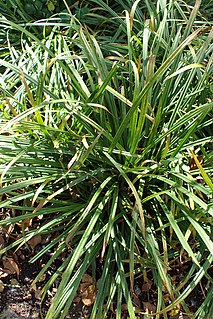
Carex gracillima, called the graceful sedge or purple-sheathed graceful sedge, is a species of flowering plant in the genus Carex, native to central and eastern Canada and the central and eastern United States. It prefers to grow in shady, wet woodlands and similar habitats.
Carex microglochin, called the fewseeded bog sedge and bristle sedge, is a species of flowering plant in the genus Carex, native to temperate and subarctic North America, South America, Europe and Asia. It is uncertain which hemisphere it originated on before dispersing to the other.

Carex divulsa, the grey sedge, is a species of flowering plant in the genus Carex, native to Macaronesia, Europe, northwest Africa, the Caucasus region, and the Middle East as far east as Turkmenistan. It has been introduced to northeast Argentina, the District of Columbia and Pennsylvania in the United States, Ontario in Canada, the North Island of New Zealand, and Tasmania and Victoria in Australia. It is the namesake of the Carex divulsa aggregate.
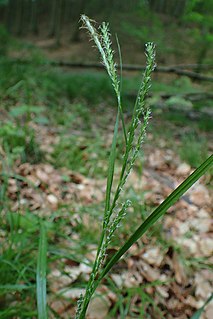
Carex strigosa, the thin-spiked wood sedge, is a species of flowering plant in the genus Carex, native to Europe and the Caucasus region. Its chromosome number is 2n=66.
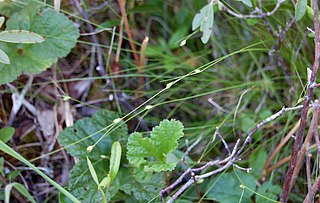
Carex trisperma, the three-seeded sedge, is a species of flowering plant in the genus Carex, native to Canada, Greenland, and the northeastern United States. It is typically found in acidic bogs within forests.

Carex squarrosa is a species of sedge, native to the central and eastern United States, and Ontario in Canada. It is typically found in bottomland hardwood forests and other wet habitats.
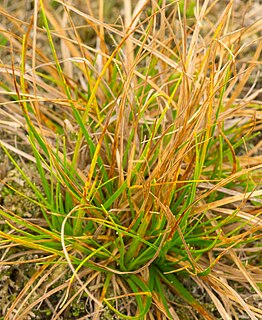
Carex umbellata, the parasol sedge, is a species of flowering plant in the genus Carex, native to Canada and the central and eastern US, and introduced to the Dominican Republic. Its seeds are dispersed by ants.
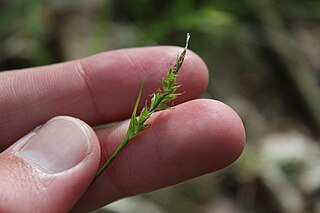
Carex communis, the fibrous-root sedge, is a species of flowering plant in the genus Carex, native to central and eastern Canada and the central and eastern United States. Its seeds are dispersed by ants.

Carex dolichostachya is a species of flowering plant in the sedge genus Carex, family Cyperaceae. It is native to eastern Asia; central and southeast China, Taiwan, the Philippines, Korea, the Ryukyu Islands, and Japan. Its popular cultivar 'Kaga-nishiki' is sold in the US by the trade designation Gold Fountains.

Carex frankii, Frank's sedge, is a widespread species of flowering plant in the family Cyperaceae, native to temperate eastern North America; Ontario, the central and eastern United States, and Coahuila, Mexico. Preferring to grow in wet, shady situations such as the edges of streams and ponds, and erosion resistant, it is recommended for rain gardens.
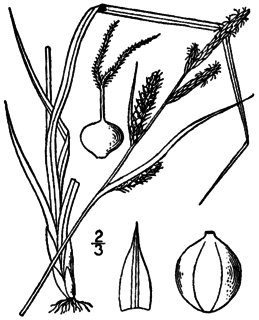
Carex haydenii, Hayden's sedge, is a species of flowering plant in the family Cyperaceae, native to eastern Canada and the north-central and northeastern United States. Preferring to grow in wet, shady situations, but able to tolerate full sun, it is recommended for rain gardens.
















